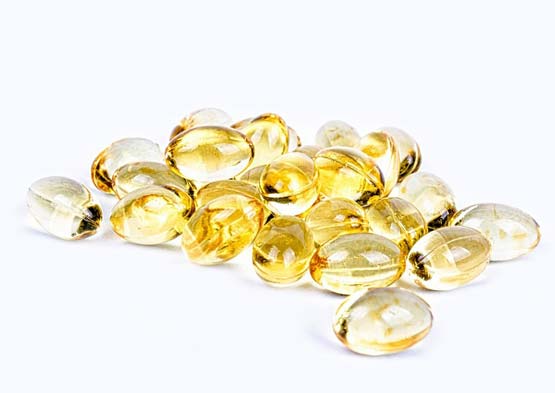
In the 1940s, vitamin D became synonymous with bone health, when it was discovered that fortifying milk with the vitamin greatly reduced the incidence of bone-deforming rickets in children. While it's true that vitamin D, along with calcium, is critical for building bone and maintaining bone density, a growing body of research suggests that vitamin D is a much more versatile vitamin than we realized 70 years ago.
THE A-B-Cs OF VITAMIN D
Vitamin D's primary job is to regulate calcium absorption. But the specifics of how vitamin D is used by the body are far more complex. Research has suggested that getting enough vitamin D may play an important role in the prevention of a wide variety of conditions and diseases, including colorectal cancer, cardiovascular disease and high blood pressure, and that it may help boost the immune system (Dermato-Endocrinology, 2013.)
Vitamin D comes in several forms; the two most commonly found in foods and supplements are vitamin D2 (ergocalciferol) and D3 (cholecalciferol). Some research suggests that vitamin D3 is more potent than D2, though Michael Holick, Ph.D., M.D., vitamin D expert and professor at Boston University School of Medicine, says, "Vitamin D2 is as effective as vitamin D3 in raising and maintaining serum blood levels of the vitamin."
GOOD VITAMIN D STATUS
Your blood level of 25-hydroxyvitamin D is the primary indicator of vitamin D status. The Institute of Medicine (IOM) says that maintaining a serum level of 20 nanograms/milliliter (ng/ML) is enough for bone health. However, Holick and others recommend higher levels (40-60 ng/ML) for overall health. The level that is considered "normal" may vary among clinical laboratories.
VITAMIN D AND DIET
Milk is fortified with about 100 IU per cup and is the major source of this vitamin in the American diet. The intake of vitamin D dropped 15 percent between 1980 and 2009, mainly due to a drop in milk consumption (Journal of the American Dietetic Association, 2011.)
A few foods, including salmon and tuna, are naturally rich in vitamin D, but several products, including some brands of orange juice and breakfast cereals, are fortified with the vitamin.
Mushrooms are possibly the least known source of vitamin D. When exposed to ultraviolet light, mushrooms can provide as much as 400 IU per three-ounce serving. Check the label to see if your mushrooms are rich in vitamin D. But if you're not a milk drinker or a mushroom fan, get little sun, or are over 50, you'll need supplements to meet recommended intakes.
THE SUNSHINE VITAMIN
Vitamin D is also produced by the body when your skin is exposed to the ultraviolet rays of the sun. These rays trigger the production of a vitamin D precursor found in skin called previtamin D3, which is then activated in the liver and kidneys. Only activated vitamin D can perform in the body.
The standard recommendation for getting your D quota from the sun is 5-20 minutes of sun exposure between 10 am and 3 pm twice a week on the face, arms, and legs without sunscreen. Vitamin D is fat-soluble, which means your body has the ability to store it for days or months, so it's OK if you don't get sun exposure every day. But this varies depending upon the following factors:
1. Skin color. Darker skin produces less vitamin D.
2. Location. Northern latitudes get fewer ultraviolet rays.
3. Age. After age 50, the skin's ability to produce vitamin D is reduced.
4. Medications. Some medications, such as corticosteroids and cholestyramine lower vitamin D levels.
5. Chronic kidney disease. This condition lowers the ability to activate vitamin D.
6. Cloud cover. Complete cloud cover reduces UV rays by 50 percent.
FUTURE OF VITAMIN D AND HEALTH
Research into the roles of vitamin D in the body continues.
"The effects of vitamin D on the immune system holds a lot of promise," says Holick. "The importance of maintaining a healthy vitamin D status through life may play an important role in reducing the risk of deadly cancers, heart disease and type 2 diabetes later in life."
VITAMIN D REQUIREMENTS
In 2010, the Institute of Medicine issued official recommendations for the amount of vitamin D individuals should take in every day for bone health: 600 International Units (IU) per day for 1-70 years of age, and 800 IU for those over 70.
The IOM said there was not enough evidence to make vitamin D recommendations for the prevention of disease or other conditions. However, some experts believe that in this case, more is better.
"I recommend 1,000 IU daily for children and 2,000 IU for adults. I, personally, take 3,000 IU daily and aim for a blood level in the range of 40-60 ng/ML," says Holick.
SOURCES OF VITAMIN D
Cod liver oil, 1 tablespoon: 1,360 IU
• Salmon (sockeye), cooked, 3 ounces: 447 IU
• Tuna fish, canned in water, drained, 3 ounces: 154 IU
• Orange juice, fortified with vitamin D, 1 cup: 137 IU
• Milk, nonfat, reduced fat and whole, 1 cup: 100 IU
• Yogurt, fortified with vitamin D, 6 ounces: 80 IU
• Margarine, fortified, 1 tablespoon: 60 IU
• Sardines, canned in oil, drained, 2 sardines; 46 IU
• Egg, 1 large (vitamin D in yolk): 41 IU
• Ready-to-eat cereal, fortified, 1/4 to 1 cup: 40 IU
Comment by clicking here.


 Contact The Editor
Contact The Editor
 Articles By This Author
Articles By This Author
